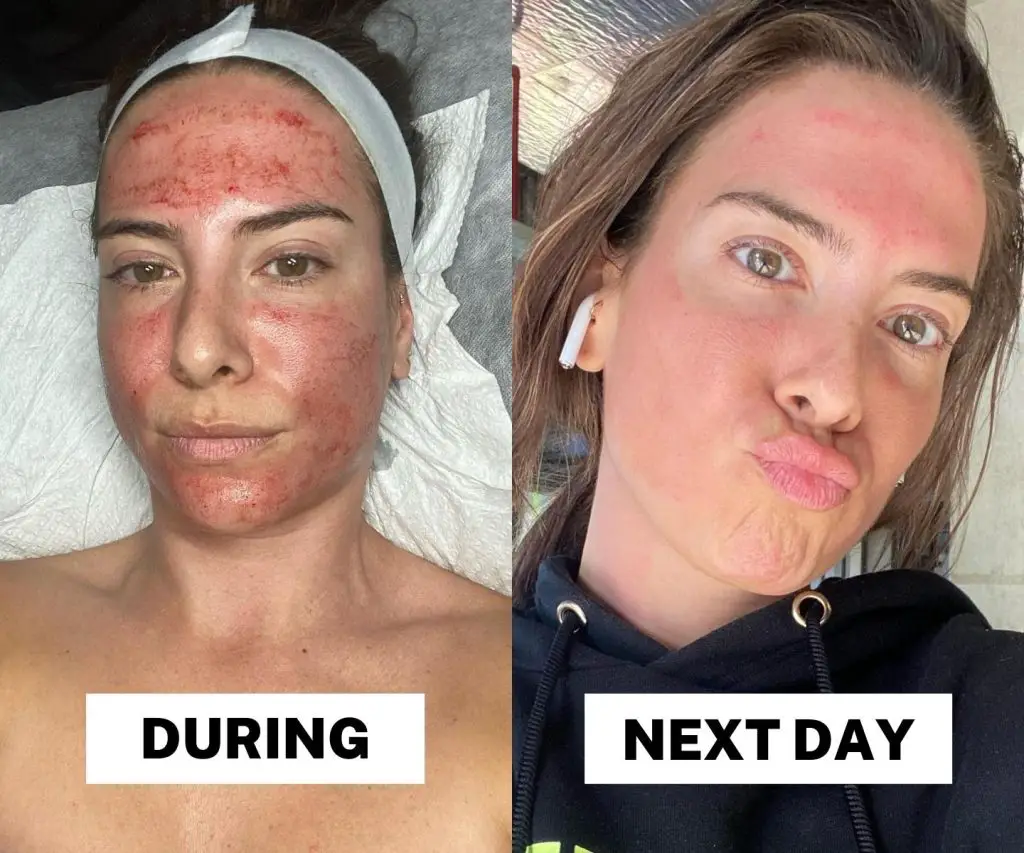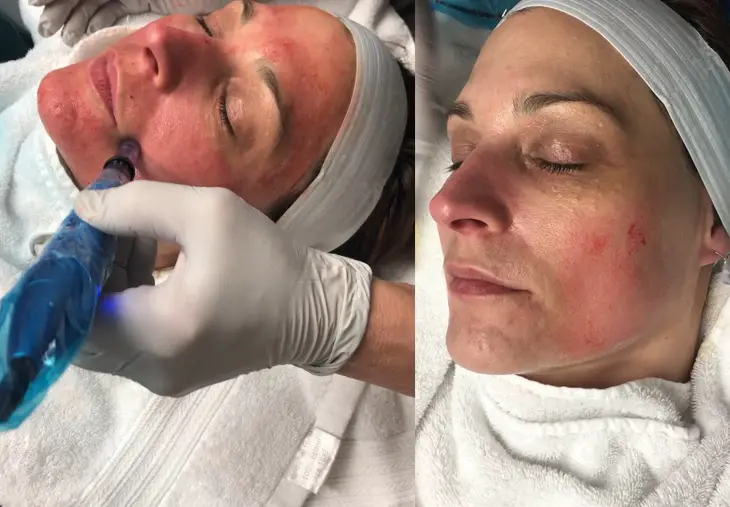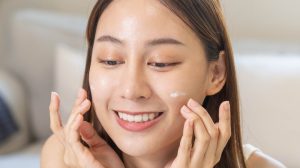Everything You Need To Know About Microneedling—What It Is, Uses, Benefits, Results
- Last Updated: April 18, 2023
If you’ve not heard of microneedling ever, it may sound like an intimidating procedure. Yes, numbing cream is involved, but the procedure is actually minimally-invasive—and comes with a plethora of skin-boosting benefits that go beyond a basic facial.
You’re stimulating collagen production and thickening the skin, so instead of looking good only for a few days post-traditional facial, your skin will remain smooth and radiant for much longer.
Of course, the idea of getting needles inserted into your face for the sake of skincare can seem intimidating, but if you’ve seen the before and after shots, there’s no questioning the treatment’s effectiveness. You’d actually be surprised.
Ahead, we explain about the treatment as a whole, including what microneedling involves, what is the aftercare process, and, of course, whether it hurts.

What Is Microneedling?
Microneedling, otherwise known as Dermapen or Rejuvapen, is a collagen induction therapy, a treatment designed to improve skin rejuvenation.
Needles are used to create tiny punctures on the top layer of the skin which would prompt the body to produce new collagen and elastin.
To be precise, the tool uses 11 super-tiny needles in the tip, which can be adjusted by your professional between 0.5 and 2.5 millimeters. The smallest setting—0.5 millimeters—penetrates the stratum cornea, or the superficial layer of skin.
Your body treats a small wound the same way it would a large wound, and sends fibroblasts to generate more collagen in the affected area. What microneedling is attempting to do is to trick your skin into thinking it has been wounded, but as a result, we’re thickening the skin and improving its texture.
The treatment can also help reduce pore size and heal acne scars.
What Happens During Microneedling Treatment?
The treatment kickstarts by first cleansing the face, then applying a topical numbing cream. Once that takes effect (about 10 to 20 minutes), your dermatologist will apply a serum that helps accelerate skin repair and healing.
A microneedling pen is then passed back and forth all over your face—at this point, the needles are moving up and down—in order to “needle in” the serum.
Once the procedure is completed, another layer of serum is applied and a mask which is used to seal everything in.
Bear in mind that microneedling is not the same procedure as the controversial platelet-rich plasma, commonly known as the vampire facial, which harnesses growth factor from your own blood, and is recommended for defying very advanced signs of aging.
Is Microneedling Painful?
The very idea of tiny needles piercing your skin sounds like it would bring a serious ouch factor, but you need not worry. Not only does the numbing cream help take away what experts agree is minimal pain during the procedure, but what you can expect post-procedure is a bit of pinkness, almost like a sunburn. At most, a few tiny punctate scabs may pop up, only to fade in the next few days.
Microneedling vs. Microdermabrasion – What’s the Difference?
Microneedling and microdermabrasion are both procedures to improve the look and texture of your skin. However, microdermabrasion doesn’t involve the use of needles. Instead, an expert uses a device called a microdermabrasion device, with a rough edge, like sandpaper, to exfoliate the topmost layer of your skin.
Microneedling on the other hand, goes deeper into your skin than microdermabrasion, so it works better for problems beneath the skin surface, such as acne scars.
Who Is Microneedling For?
One of the microneedling benefits has to do with its ability to treat acne scarring, and because it doesn’t use heat and is totally mechanical, it’s safe for all skin colors and types. The treatment works great for smoothing out the skin and filling in acne scars, but if you’re experiencing clogged pores, it can help to clear that up as well.
You might consider microneedling if you have the below concerns:
- Enlarged pores
- Fine lines or wrinkles
- Sagging skin
- Mild scars, especially those from acne or burns
- Skin discoloration or uneven skin tone
- Stretch marks
The procedure can also help individuals with medical conditions such as:
- Alopecia areata (hair loss due to an autoimmune disease).
- Hyperhidrosis (excessive sweating).
Just make sure there aren’t any inflamed or infected areas on your skin, and if you have a cystic breakout, wait until it clears up before going in for your appointment. You should also steer clear of microneedling if you have eczema, rosacea, or very sensitive skin.
On top of that, you should also skip the procedure should you be on blood thinner or a frequency alcohol consumer, which can result in dehydration and can render the procedure ineffective.
Can You Microneedle Your Body?
For sure! Microneedling isn’t just exclusive to the face. While it’s the area of skin that is most often treated, the procedure can be done anywhere you consider requires a collagen boost, particularly those that have stretch marks, like the legs, thighs, or buttocks.
How Often Should I Get Microneedling Done?
“Microneedling how often” you may ask. It all depends on the severity of the skin issue you’re looking to fix. If your skin is generally fine and you’ve been taking good care of it, you can microneedle every three to six months. However, someone with critical acne scarring should consider doing one session per month for four to six months.
Then, you should plan on coming in once a year for touch-ups, especially if you feel like your skin needs a reboot. In terms of other parts of the body, you can expect about four to six sessions to see the result.
What Is Microneedling Aftercare Like?
Amongst the common microneedling side effects is redness and sensitivity. We advise you to slather on a broad-spectrum, chemical-free sunscreen with at least SPF 30 during the weeks following your treatment (or always).
You should also steer clear of retinol and acids, such as glycolic and salicylic acid. These active ingredients are too strong right after microneedling is done.
Make sure you keep your skin hydrated by applying a mild hydrating serum and use a gentle, mild cleanser. Avoid exfoliating scrubs in the days immediately following the treatment.
Ideally, you’ll also want to avoid putting on makeup for the rest of the day, but if you have commitments to attend to, it’s totally safe to wear later in the night.
How Do At-Home Microneedling Pens Compare?
Intrigued about at-home microneedling tools and how they measure up to in-office treatments?
Needles in at-home devices are generally shorter and don’t penetrate the skin as deep, making them safe to use, but you won’t yield the same results as heading to your dermatologist clinic.
Coming in for a microneedling treatment is like working out with a professional trainer, whereas a dermaroller is like working out at the gym by yourself. The latter is undoubtedly great, but you’ll achieve more significant results with a professional
If you choose to incorporate an at-home dermaroller into your skincare routine, we advise doing it on completely cleansed skin before bed, then applying a serum over the top.
How Long Does it Take to See Results From Microneedling?
After a microneedling treatment, you will look plump, pink, and luminous for a couple of weeks. On a short-term basis, it plumps the skin and alleviates any inflammation and superficial swelling. However, because the efficacy of microneedling comes from the skin healing itself, some individuals may only see significant results after a few sessions. It’s important to note that microneedling promises improvement over time. Treating the skin with multiple microneedling sessions spread at least one month apart can produce an increase in collagen and skin elasticity.

How Long Can the Results from Microneedling Last?
Microneedling alone can only give temporary results that don’t last. To yield optimal results, we recommend combining microneedles with radio frequency for permanent wrinkle and scar reductions, and an overall enhanced skin condition.

Celine So
Be mindful of your words as they are impactful, which also explains why I am so fond of writing.



